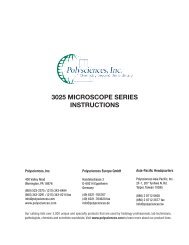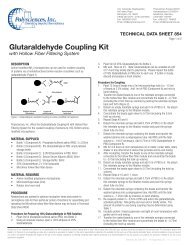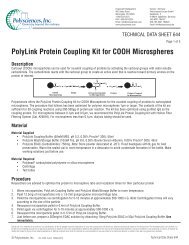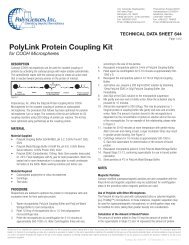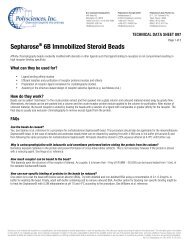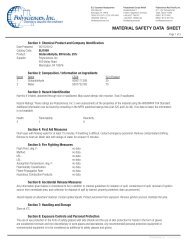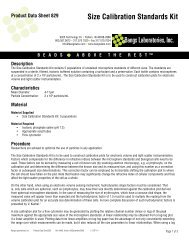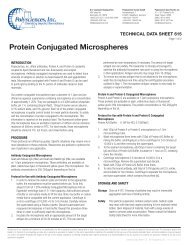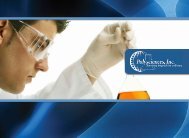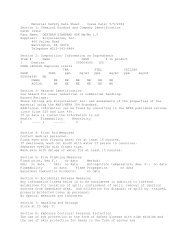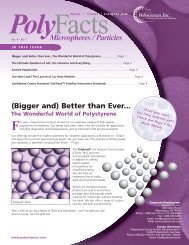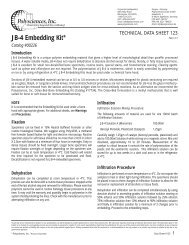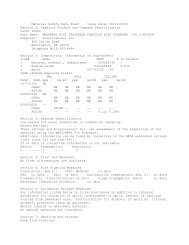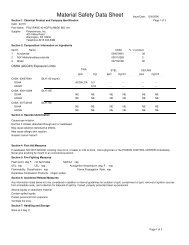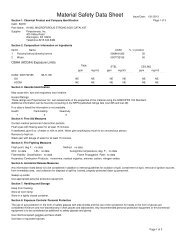BioSciences - Polysciences, Inc.
BioSciences - Polysciences, Inc.
BioSciences - Polysciences, Inc.
Create successful ePaper yourself
Turn your PDF publications into a flip-book with our unique Google optimized e-Paper software.
Histology & Microscopy<br />
Certified Dyes & Stains<br />
<strong>BioSciences</strong><br />
Acid Fuchsin, C.I. 42685, Certified [989-38-8] ...................................<br />
MW 585.24 C 20 H 17 N 3 Na 2 O 9 S 3<br />
Used in the Masson’s Trichrome Staining technique. This method is commonly used to stain tissue<br />
sections in the Histology and Cytology Laboratory in order to distinguish muscle from collagen. The<br />
muscle stains red with the acid fuchsin and the collagen is stained green or blue with light green SF<br />
yellowish or methyl blue.<br />
Jocelyn H. Bruce-Gregorios, M.D.: Histopathologic Techniques, JMC Press <strong>Inc</strong>., Quezon City, Philippines, 1974.<br />
Acridine orange, C.I. 46005, very high purity [65-61-2] HU5e .....................<br />
(3,6-Bis[dimethylamino]acridine hydrochloride hydrate ) MW 301.83<br />
DNA intercalating dye. A grade of acridine orange of exceptionally high purity, suitable for quantitative<br />
work. Free of inorganic salts. A specific stain for RNA, used as a 2% solution containing 1% lanthanum<br />
acetate in 15% acetic acid.<br />
Histochem. Cytochem., 22, 495 (1974); 31, 737 (1983); 44, 393 (1996); 49, 921 (2001); J. Lab Med., 15(3), 180 (1984)<br />
Acridine yellow G, C.I. 46025 [135-49-9] HU4g ..................................<br />
Fluorochrome used in insect histology and Schiff’s reagent for periodate-positive fungi.<br />
Conn’s Biological Stains, 9th Ed., 1977; p358<br />
Alcian Blue 8GX, C.I. 74240 [33864-99-2] .......................................<br />
Used primarily for demonstrating acid mucopolysaccarides with Scott’s method and Mowry’s staining<br />
methods. Used in electrophoresis for detecting glycoproteins.<br />
Aniline Blue, C.I. 42755, certified, water-soluble [28631-66-5] U5g ................<br />
(Acid blue 22) MW 739.7<br />
Used as contrast stain in histology and cytology and as a pH indicator (pH 10.0-13.0).<br />
Used with acid fuchsin as Mallory’s connective tissue stain. Also used to visualize chromosomes and<br />
cellulose wall implants. J. Histochem. Cytochem., 31, 823 (1983)<br />
Azure A, C.I. 52005, Certified [531-53-3] .......................................<br />
MW 291.8 C 14 H 14 ClN 3 S<br />
Certified for use in Lillie’s modified Nocht’s method for paraffin sections and the NCCLS method<br />
for blood smears.<br />
IR-Spectra (3), 1486:G / RegBook 1 (2), 2815:E / Stains and Dyes Ref, 109 / Structure Index 1, 447:B:6, Penny, DP et al, Analysis<br />
and testing of biological stains - The Biological Stain Commission Procedures Biotech. Histochem. 77(5&6), 237-275, (2002)<br />
Biebrich scarlet, C.I. 26905 [4196-99-0] U4g ....................................<br />
(Acid red 66; Ponceau B) MW 556.49 C 22 H 14 N 4 Na 2 O 7 S 2<br />
Widely used as a counterstain, as well as useful plasma stain.<br />
Brilliant Cresyl Blue, C.I. 51010, Certified [81029-05-2] ...........................<br />
(Brilliant Blue C, Brilliant Cresyl Blue) MW 385.96 C 17 H 20 N 3 OCl · 1/2 ZnCl 2<br />
Color Index Number: 51010 Grade: Certified Biological Stain<br />
Certified is used for a supravital stain for reticulocytes.<br />
Penny, DP et al, Analysis and testing of biological stains - The Biological Stain Commission Procedures Biotech. Histochem.<br />
77(5&6), 237-275, (2002)<br />
Brilliant Green, C.I. 42040, Certified ...........................................<br />
(Malachite Green G, Basic Green 1, Emerald Green) MW 482.63 C 27 H 34 N 2 NO 4 S<br />
Color Index Number: 42040 Grade: Certified Biological Stain<br />
Brilliant Green, Certified is used as a bacteriostatic agent for the selective enrichment and enumeration<br />
of E. coli and other fecal coliform organisms in water, milk and food.<br />
Penny, DP et al, Analysis and testing of biological stains - The Biological Stain Commission Procedures Biotech. Histochem.<br />
77(5&6), 237-275, (2002)<br />
Carmine, C.I. 75470, certified [1390-65-4] U5g ..................................<br />
(Natural red 4; Cochineal) Used in microscopy for making various stains including stains for glycogen,<br />
mucin, nuclei and chromosomes. Clark, G., Staining Procedures, 4th ed., Williams and Wilkins, 1981; p 111, 195, 212, 342<br />
Chlorazole black E, C.I. 30235, certified [1937-37-7] M6g .........................<br />
MW 781.7<br />
A valuable stain in general histology and cytology. Gives sharp, clear-cut pictures of both nuclei and<br />
cytoplasmic structures. Also useful for differentiation of fungi. Nature, 139, 549 (1937); Stain Technol., 39, 81 (1964)<br />
Catalog # Size<br />
24991-25 25 g<br />
24991-100 100 g<br />
04539-500 500 mg<br />
04539-5 5 g<br />
22279-10 10 g<br />
19175-10 10 g<br />
02570-25 25 g<br />
24992-25 25 g<br />
24992-50 50 g<br />
03336-100 100 g<br />
24993-25 25 g<br />
24993-50 50 g<br />
24994-25 25 g<br />
24994-50 50 g<br />
02729-25 25 g<br />
02730-25 25 g<br />
For more information please call (800) 523-2575 or visit: polysciences.com 11



